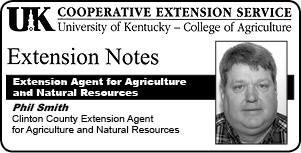Timely tips

Dr. Roy Burris, University of Kentucky Beef Specialist
Spring-calving cow herd
• Culling decisions should be made prior to winter feeding for best use of feed resources. Consider open, poor-producing and aged cows as candidates for culling.
• Evaluate body condition of cows after weaning their calves. Sort thin (less than CS5) cows away from the cow herd and feed to improve their condition. Two and three-year olds may need extra attention now.
• Dry cows in good condition can utilize crop residues and lower quality hay now (but don’t let them lose any more body condition). Save higher quality feed until calving time. Keep a good mineral supplement with vitamin A available.
• Replacement heifers require attention during the winter, too. Weaned heifer calves should gain at an adequate rate to attain their “target” breeding weight (2/3 of their mature weight) by May 1.
• If you need to replace cows, consider buying bred heifers in some of the Kentucky Certified Replacement Heifer sales which are being held across the state this month.
• A postweaning feeding period will allow you to put rapid, economical gains on weaned calves, keep them through the fall “runs” and allow you to participate in Kentucky CPH-45 sales. Consider this health and marketing program which is designed for producers which are doing a good job of producing high quality feeder calves.
Fall-calving herd
• Continue to watch fall-calving cows this month. Catch up on processing of calves including identification, castration and vaccinations.
• Vaccinate the cows while they are open and prior to the breeding season. Move cows to accumulated pasture or increase feed now.
• Start the breeding season about November 25 for calving to begin in September of 2012. If you are using AI and/or estrous synchronization, get your supplies together now. Don’t forget Breeding Soundness Evaluations (BSE) on your bulls. Make final selection of replacement heifers now.
General
• Have your hay supply analyzed for nutritive quality and estimate the amount of supplementation needed. Consider purchasing feed now.
• Don’t waste your feed resources. Avoid excessive mud in the feeding area. Hay feeding areas can be constructed by putting rock on geotextile fabric. Feed those large round bales in hay “rings” to avoid waste.
• This is a good time to take soil tests and make fertility adjustments (phosphate, potash and lime) to your pastures.
• This is also a good time to freeze-brand bred yearling heifers and additions to the breeding herd.
• Graze alfalfa this month after a “freeze-down” (24 degrees for a few hours).
